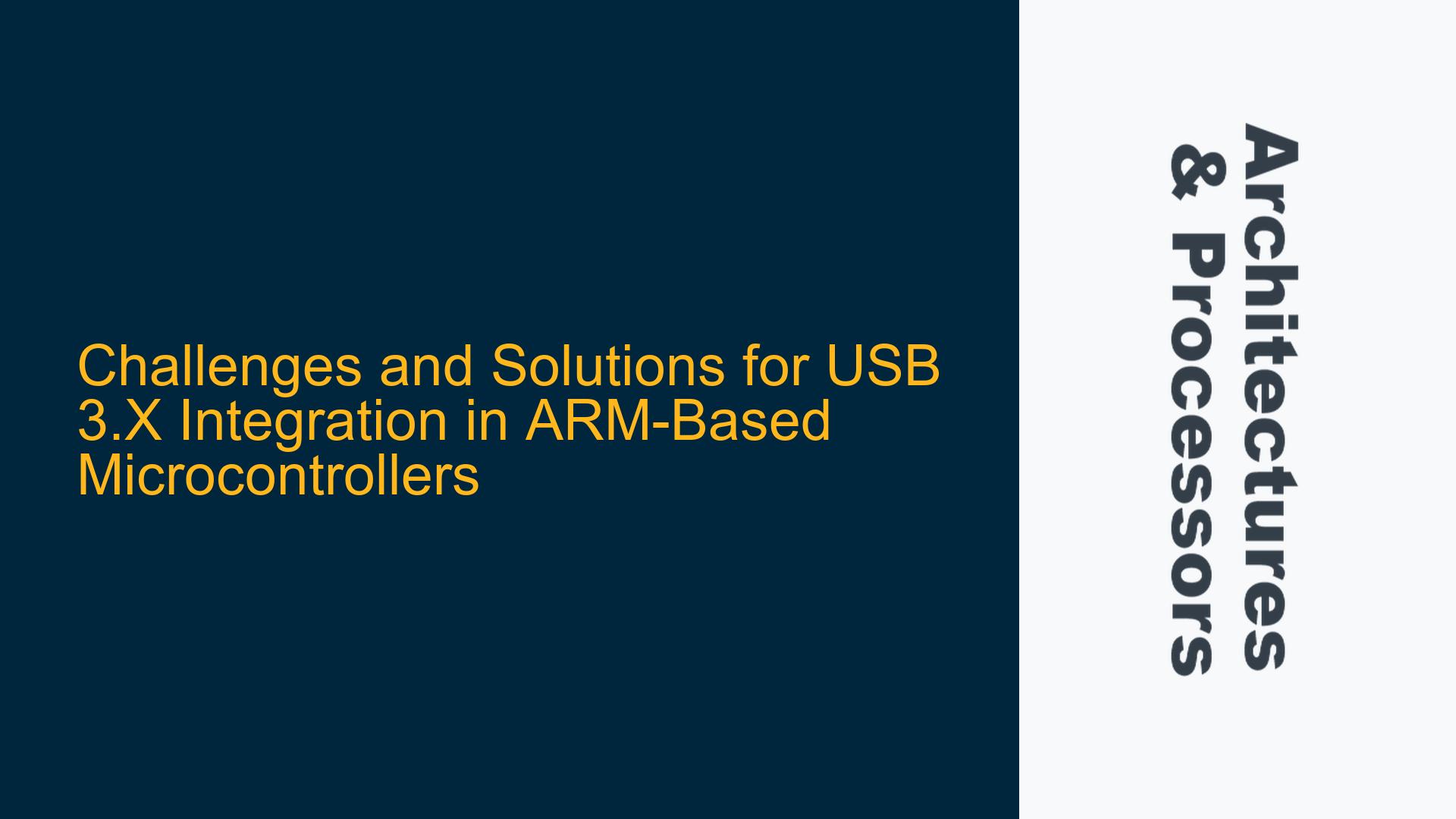USB 3.X Implementation Challenges in ARM-Based Microcontrollers
The integration of USB 3.X interfaces into ARM-based microcontrollers presents a unique set of challenges that have contributed to its limited adoption. USB 3.X, which includes USB 3.1 Gen 2 (USB3.2 Gen 2 x1) and USB 3.2 Gen 2 x 2, offers significant improvements in data transfer rates compared to USB 2.0 and USB 3.0. However, the complexity of implementing these high-speed interfaces within the constraints of ARM-based microcontrollers has led to a scarcity of such implementations.
One of the primary challenges is the increased complexity of the USB 3.X protocol itself. USB 3.X operates at significantly higher speeds, with USB 3.1 Gen 2 supporting data rates of up to 10 Gbps, and USB 3.2 Gen 2 x 2 doubling that to 20 Gbps. These high data rates require precise timing and signal integrity, which can be difficult to achieve in the context of a microcontroller. The ARM architecture, while highly efficient and versatile, is often optimized for lower power consumption and cost-effectiveness, which can conflict with the demands of high-speed USB interfaces.
Another challenge is the increased power consumption associated with USB 3.X. The higher data rates and additional signaling requirements of USB 3.X can lead to increased power consumption, which is a critical consideration for battery-powered devices. ARM-based microcontrollers are often used in applications where power efficiency is paramount, and the additional power requirements of USB 3.X can be a significant drawback.
Furthermore, the integration of USB 3.X into ARM-based microcontrollers requires additional hardware components, such as PHY (Physical Layer) interfaces and high-speed transceivers. These components add to the overall cost and complexity of the microcontroller, which can be a barrier to adoption, especially in cost-sensitive applications.
ARM Microcontroller Architecture Constraints and USB 3.X Compatibility
The architecture of ARM-based microcontrollers presents several constraints that can impact the compatibility and performance of USB 3.X interfaces. ARM microcontrollers are typically designed with a focus on low power consumption, cost-effectiveness, and ease of integration, which can sometimes be at odds with the requirements of high-speed USB interfaces.
One of the key architectural constraints is the limited availability of high-speed interfaces within the ARM microcontroller ecosystem. Many ARM microcontrollers are designed with USB 2.0 interfaces, which are sufficient for a wide range of applications but do not meet the performance requirements of USB 3.X. The transition to USB 3.X requires significant changes to the microcontroller’s architecture, including the addition of high-speed transceivers, PHY interfaces, and support for the more complex USB 3.X protocol.
Another architectural constraint is the limited memory bandwidth and processing power of many ARM microcontrollers. USB 3.X interfaces require high data throughput and low latency, which can strain the resources of a microcontroller. The ARM architecture, while highly efficient, may not always provide the necessary performance to fully leverage the capabilities of USB 3.X. This can result in bottlenecks and reduced performance, particularly in applications that require high-speed data transfer.
Additionally, the integration of USB 3.X into ARM microcontrollers can be complicated by the need to support multiple power domains and clock domains. USB 3.X interfaces require precise timing and synchronization, which can be challenging to achieve in a microcontroller environment. The ARM architecture typically operates at lower clock speeds compared to high-performance processors, which can make it difficult to meet the timing requirements of USB 3.X.
Strategies for Successful USB 3.X Integration in ARM-Based Designs
Despite the challenges, there are several strategies that can be employed to successfully integrate USB 3.X interfaces into ARM-based microcontrollers. These strategies involve a combination of hardware and software optimizations, as well as careful consideration of the design constraints and requirements.
One of the key strategies is the use of dedicated USB 3.X PHY interfaces and high-speed transceivers. These components are essential for achieving the high data rates and signal integrity required by USB 3.X. By integrating these components directly into the microcontroller, it is possible to reduce the complexity and cost of the overall design. Additionally, the use of advanced packaging techniques, such as System-in-Package (SiP) or Chip-on-Board (CoB), can help to minimize the footprint of the USB 3.X interface and improve overall performance.
Another important strategy is the optimization of the ARM microcontroller’s memory and processing resources. This can be achieved through the use of high-performance memory interfaces, such as DDR3 or DDR4, and the implementation of efficient data transfer mechanisms, such as Direct Memory Access (DMA). By optimizing the memory and processing resources, it is possible to reduce bottlenecks and improve the overall performance of the USB 3.X interface.
In addition to hardware optimizations, software optimizations are also critical for successful USB 3.X integration. This includes the development of efficient USB 3.X drivers and firmware, as well as the implementation of advanced power management techniques. By optimizing the software stack, it is possible to reduce power consumption and improve the overall efficiency of the USB 3.X interface.
Finally, careful consideration of the design constraints and requirements is essential for successful USB 3.X integration. This includes a thorough analysis of the timing and synchronization requirements, as well as the implementation of robust testing and validation procedures. By addressing these challenges early in the design process, it is possible to minimize the risk of issues and ensure the successful integration of USB 3.X into ARM-based microcontrollers.
Future Prospects for USB 4.0 in ARM-Based Microcontrollers
The recent announcement of USB 4.0 by the USB Implementers Forum (USB-IF) has sparked interest in the potential for its integration into ARM-based microcontrollers. USB 4.0, which is based on the Thunderbolt 3 protocol, offers even higher data transfer rates of up to 40 Gbps, as well as improved power delivery and display capabilities. However, the integration of USB 4.0 into ARM-based microcontrollers presents a new set of challenges and opportunities.
One of the key challenges is the increased complexity of the USB 4.0 protocol. USB 4.0 introduces new features, such as tunneling of multiple protocols (e.g., PCIe, DisplayPort) over a single USB-C connection, which requires significant changes to the microcontroller’s architecture. Additionally, the higher data rates and increased power delivery capabilities of USB 4.0 require advanced hardware components, such as high-speed transceivers and power management ICs, which can add to the overall cost and complexity of the design.
Despite these challenges, the integration of USB 4.0 into ARM-based microcontrollers offers several potential benefits. The higher data transfer rates and improved power delivery capabilities of USB 4.0 can enable new applications and use cases, such as high-performance embedded systems, IoT devices, and portable computing devices. Additionally, the improved display capabilities of USB 4.0 can enable the development of new types of user interfaces and display technologies.
To successfully integrate USB 4.0 into ARM-based microcontrollers, it will be necessary to address the challenges of increased complexity and power consumption. This will require a combination of hardware and software optimizations, as well as careful consideration of the design constraints and requirements. By leveraging the strengths of the ARM architecture and the capabilities of USB 4.0, it is possible to develop high-performance, power-efficient microcontrollers that meet the demands of next-generation applications.
In conclusion, while the integration of USB 3.X and USB 4.0 into ARM-based microcontrollers presents significant challenges, it also offers exciting opportunities for innovation and development. By addressing the challenges of complexity, power consumption, and performance, it is possible to successfully integrate these high-speed interfaces into ARM-based designs and unlock new possibilities for embedded systems and IoT devices.






